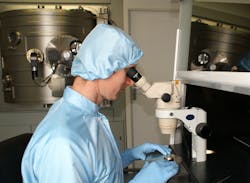Garbsen, Germany[email protected]
-----
PRESS RELEASE
Extremely low loss laser mirrors
In order to produce low loss super mirrors with a very high reflectivity, the coating experts from LASEROPTIK have equipped one of their IBS machines in a special cleanroom environment for this purpose. Super mirrors are used for ring laser gyroscopes and need to have scattering losses at 633nm below 10ppm which can be
achieved by ion beam sputtering (IBS).
The total back scattering (TSb, as refer to ISO 13696) of such a mirror taken from LASEROPTIK’s current production has been measured at the Fraunhofer Institute for Applied Optics and Precision Engineering in Jena and achieved a value of TSb=1,1ppm. At a typical absoption and rest transmission of together <15ppm this equals a reflectivity of at least 99,998% and gets very close to the perfect laser mirror with R=100%.
The results could be confirmed by LASEROPTIK’s in-house cavity ringdown setup and scatter measurement. A critical condition for the above mentioned values is using super-polished substrates with a surface roughness <1Å rms. Their quality is inspected with a whitelight interferometer.
Apart from low loss mirrors, IBS is also applied for complex filter designs, GDD-optimized fs-mirrors or thin-film polarizers with high extinction ratio requirements.
